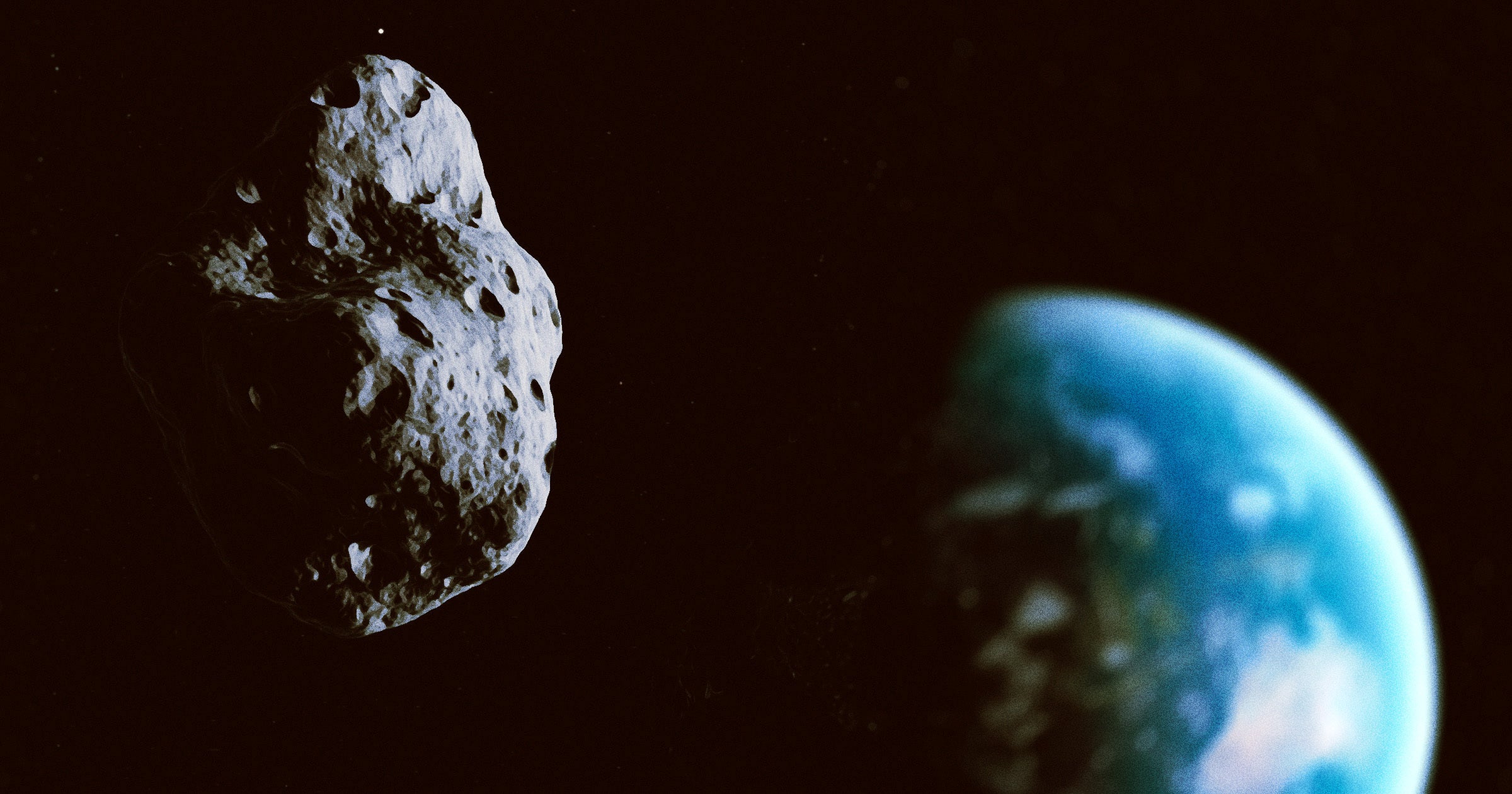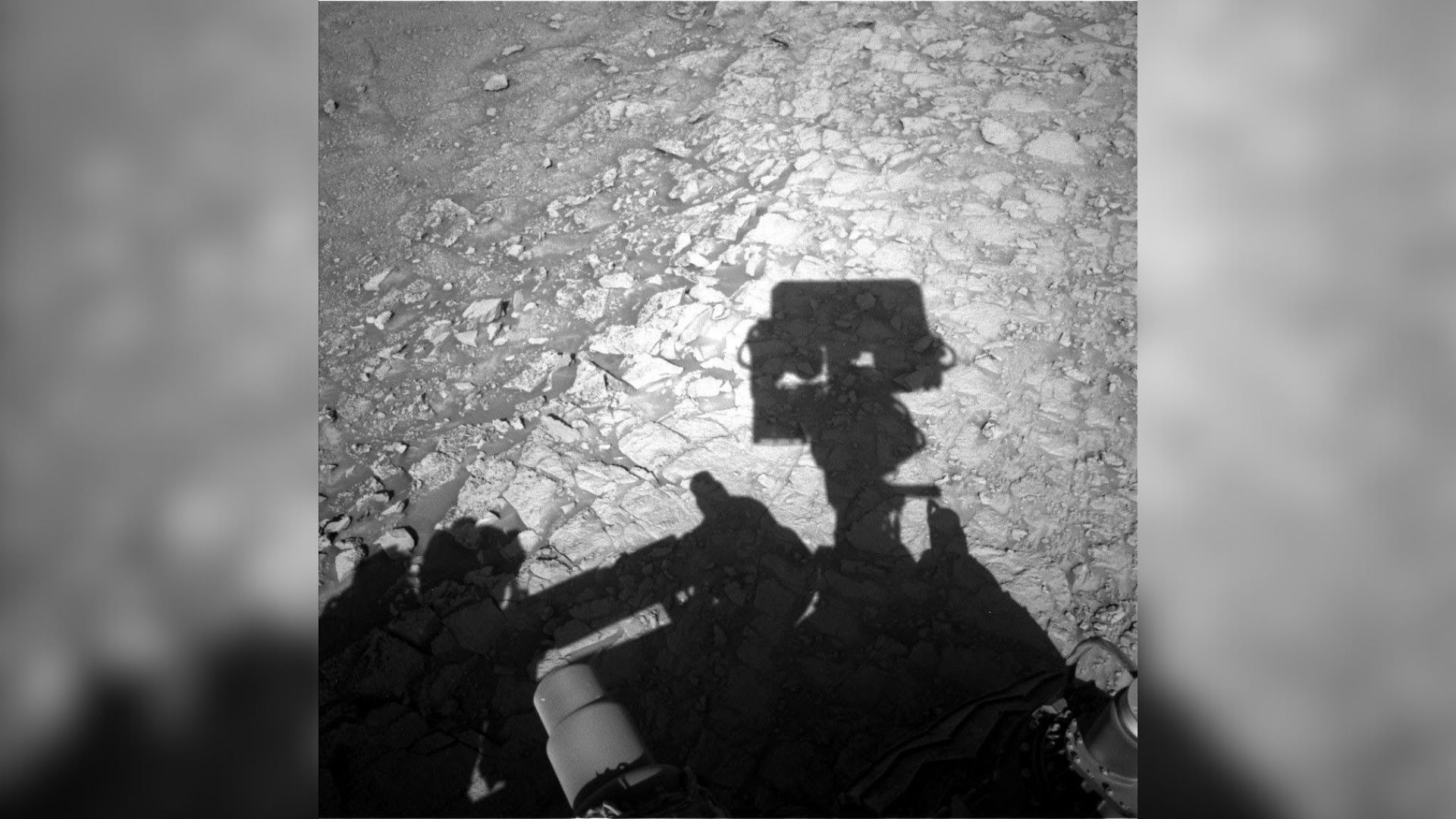Paul Rand: And when you talk about it being a habitable planet, habitable to what, to whom?
Edwin Kite: So if you or I got on a time machine, hit the buttons at random and went back to some point in Earth history, 90% of the time we would die as soon as we opened the airlock door. So our own planet has only been habitable to complex life for roughly the last 400 million years. Before that time, there wasn’t enough oxygen in the atmosphere. And so our planet was a planet of microbes. And so when we look out into the solar system and even into exoplanets, we’re mostly looking for simple single-celled life. Are there are other worlds in the universe where humans could move to? I don’t think of Mars as a backup planet. It’s very hostile to life now. It was habitable in the past, but it’s very hostile to life now. It’s cold, there’s almost no atmosphere. The atmosphere that there is isn’t thick enough to shield you from galactic cosmic radiation. Ultraviolet light goes down to the surface in punishing quantities and the soil is toxic to most forms of Earth life.
Paul Rand: But besides that, it’s pretty good.
Edwin Kite: Exactly. So Mars is not a backup plant for us. Moreover, it’s not an escape from humanity’s problems, because we tend to bring most of our problems with us.
Paul Rand: Okay, well, part of this is where it starts getting really interesting is when, as you said, the research is going and there’s pictures of really giant canyons and riverbeds and the whole concept that at one point there was flowing water and maybe even life on this planet, is that right?
Edwin Kite: So we see dry riverbeds and minerals that formed in water over the ancient part of the planet, but when we look at the younger rocks, they lacked that evidence. So there was a big climate change and it was a pretty severe one, and it probably happened a billion or more years ago. That raises two questions. What was the greenhouse effect, the natural greenhouse effect that made Mars warm enough to melt the ice a billion years or more ago? And then what changed to cause the frozen and dry planet we see today?
Paul Rand: Okay, if we go back and go back to your time machine for a moment and we’re back in a period where there is flowing rivers, there is water, there is activity happening, open our eyes and tell me what it is that you think you might be seeing.
Edwin Kite: Well, I think a big change is that you would probably see a blue sky. With more atmosphere, you get more scattering of sunlight, and that’s what gives us the blue sky. Another change is, well, I hope you’re still wearing a face mask because that air is going to be mostly carbon dioxide and nitrogen. We don’t have good evidence for an oxygen-rich atmosphere on early Mars. The ground would probably be sludgy or muddy because there was snowmelt or rain back then and there would be streams and lakes over the surface. And we know there were seas. We don’t know if there was a big ocean, that’s still unclear because the place where the ocean would be, the low spot on the planet is mostly covered by young lava. So it’s hard to figure out if it was an ocean. So there would be clouds, there might be rainfall, but there would definitely be snowmelt.
Is life part of the picture? We don’t know. Microbial fossils on Earth are hard find. To do the same job on Mars, we’ll probably need to return samples in order to interrogate them in our best Earth laboratories rather than just relying on the rover instruments. The rover instruments are exquisite, but they are optimized for low mass in order to take them to Mars relatively inexpensively. If we can bring samples back to Earth, then we can use the best laboratories we have, which tend to fill basements.
Paul Rand: Wow, okay. And so how many years ago would you speculate that was the last period that Mars was like what you’re describing?
Edwin Kite: One billion years ago or more. We don’t have radiogenic age dating on Mars except in a handful of locations. And so we don’t have as good chronology for Mars as we do for us. The good news is you don’t need that many samples to get that good chronology. And so one or two sample return missions should allow us to make a more precise statement. And we know that because the Apollo astronauts returned rocks on the moon and that allows us to give a pretty good lunar chronology.
Paul Rand: So billions of years ago, Mars actually had a much thicker atmosphere and that helped trap heat and made liquid water possible on the surface. And part of what maintained that atmosphere was a carbon cycle, and that’s what keeps Earth’s atmosphere stable for instance. Talk to me about the carbon cycle first on Earth and that on Mars.
Edwin Kite: The basic idea is that carbon dioxide comes out of volcanoes. If there wasn’t any process removing carbon dioxide from the atmosphere, the carbon dioxide level will build up and build up and you’d have a very uncomfortably hot climate. But what actually happens on our planet, we think, is the rock weathering balances that by basically reacting carbon dioxide in the atmosphere with the rocks to make a salt, calcite, which then returns the carbon to the rocks. And indeed, even though that process is too slow to affect human-induced carbon dioxide emissions, there are many companies that are working on trying to speed up that process, enhanced rock weathering in the hope that it can contribute to balancing human greenhouse gas emissions. But to be clear, the enhancement you would need would be a factor of many thousands because it’s a slow versus naturally, but one that balances, again, slow volcanic emissions.
Okay. So what’s the key that makes this stabilized climate? The key is that the rock weathering speeds up when the temperature goes up. If your greenhouse gas emissions go up for some reason, geologic, coincidence, plate tectonics, you just have a mantle plume, then that will make the planet hotter because carbon dioxide is a greenhouse gas, but that will strengthen the rock weathering process. So you have a nice negative feedback. When we look for long-term climate stability on exoplanets or Mars, we’re looking for processes like that. Recently, Curiosity has been finding carbonate deposits.
Paul Rand: I was going to ask you about that.
Edwin Kite: Yeah, yeah, yeah. That suggests that some kind of carbon cycle operated on early Mars. So we think Mars had a lot more carbon dioxide early on, but then it lost it either to space or with the carbon dioxide being locked up in minerals. But until recently, we haven’t found the minerals. Now Curiosity has found a large reservoir of carbonate rocks that we think corresponds to where the early thick atmosphere went.
Paul Rand: Can you explain before you go on, what is a carbonate material?
Edwin Kite: Yeah, so limestone is made mostly of calcite, which is a mineral that contains carbon locked up in the rock. If you see a limestone cliff, that’s a lot of carbon dioxide that ultimately came from a volcano that’s entombed or sequestered or not contributing to the greenhouse effect anymore. And if you look at Earth’s total carbon budget, if you took all the limestone on Earth and you cooked it to release the carbon dioxide, you would get an atmosphere that looks like Venus, meaning 100 bars of carbon dioxide in the atmosphere at uninhabitably hot temperatures. So it’s the limestone, it’s the carbonate, that formation is what prevented us from turning into Venus. So-
Paul Rand: Okay, fascinating. Fascinating.
Edwin Kite: Thank you to the limestone, yeah.
Paul Rand: Well, one of the, to me anyway, really striking idea is that came out of your work is this concept that Mars was likely habitable in short bursts. And I think you actually talked about it that there were brief periods as you mentioned, where there could have been liquid water and then there were 100 million year deep freezes. Tell us about that. How did you come to come up with that conclusion and what does that actually tell us?
Edwin Kite: So Mars doesn’t look as eroded or as weathered as it would look if it had rained on Mars for a billion years. There are spectacular river valleys and they form this sort of dense tree-like network covering about half of the planet’s surface. But when you measure that depth, they’re not that deep. And if you rained on Earth for a billion years and you didn’t have any plate tectonics, then you would have much deeper rivers than we see. So that’s an example. Okay, so that just says that the total amount of time the weathering erosion happened wasn’t that great, but then the total time span, the earliest weathering erosion versus the latest weather erosion, that was very long. So if you put those two together, it seems natural that you had spikes with gaps. The purpose of our recent work on the modeling of what carbonate formation would do on early Mars was motivated by that inference. It wasn’t the first time anyone had made that connection.
Paul Rand: Okay. And what conclusions came out of that insight?
Edwin Kite: So our basic idea coming out of the modeling work was that Mars could self-regulate as a desert planet. So you could have a carbon cycle that like Earth, picked a temperature and kept the temperature roughly the same, but that temperature would be close to the freezing point of water. So it would be a mostly uninhabitably cold and dry planet with only brief blips of habitability. Now, our work only considers the last three and a half billion years of Mars history, the first billion years of Mars history between the planet’s formation at 4.5 and our starting point at 3.5, that could be a more habitable time or more Earth-like time. But it’s harder to know, it’s hard to investigate that earlier time because of impacts and volcanic eruptions that bury the evidence. And so that’s another reason why Mars sample return is a high priority for many scientists. The Perseverance rover is collecting fragments of that most ancient record, which may be the best time to look for a Martian origin of life, but it’s hard to make sense of that with the data from the other rovers.
Paul Rand: Do you hope with all this exploration one day you’ll come back and find out that they’ve discovered some microfossils? And if so, what would that tell you?
Edwin Kite: It’s plausible, but right now we don’t have any evidence that life established itself on Mars. The Perseverance rover and the Spirit rover have found intriguing textures that on Earth are often a signature of microfossils, but that’s not decisive and so you would need to bring the samples back to be sure. I think if we did find microfossils on Mars, that would immediately stimulate an effort to look for water deep underground on Mars and then drill into those water pockets if we find them to look for relics, life that has persisted since that earliest era, because it’s hard to do much with a microfossil. You can do a lot of geochemistry, but you can’t read its DNA because that degrades fast. You might be able to say whether or not you had an independent origin of life from us or not, but you would have trouble going beyond that.
Paul Rand: Okay. And so in basic terms, what happened on Mars that made this perception of habitable life area go away?
Edwin Kite: Yeah, so Mars is a small planet. It’s fate may be overdetermined in the sense that there were many things about Mars that made it unable to support a habitable planet for a long period. Things that definitely matter are Mars can lose atmosphere to space more easily than a high-mass planet like Earth. So it probably lost a lot of its-
Paul Rand: What does that mean lose atmosphere to space?
Edwin Kite: One loss process is that the solar wind can strike Mars’ atmosphere because it doesn’t have a global magnetic field to stand-off the solar wind, so the solar wind can remove atmosphere. Another process is that light from the sun gets absorbed in the upper atmosphere causing it to puff up and the atmosphere at the edge can be lost again, to interstellar space, ultimately. A third process is just impact erosion. So this isn’t a big process in the modern soil system, but when the soil system was young, there were lots of asteroids and comets flying around and those could remove material from Mars’ atmosphere due to the low gravity more easily than they could from the Earth’s atmosphere. So there’s just a few of the processes, but they’re all made easier by the lower gravity of Mars. And I think you had Jacob Bean on your podcast recently.
Paul Rand: We did, we did. One of your colleagues.
Edwin Kite: Yeah, so this is closely related to the cosmic shoreline concept, which is that we expect that exoplanets that are close to their star and have low gravity will lack atmosphere, whereas exoplanets that are far from the star and have strong gravity will have [inaudible 00:19:05]. Now that’s a hypothesis to be tested, but it lines up with Mars because Mars is sort of on the boundary line so you might expect it to have a pretty tenuous atmosphere, which is indeed what we see.
Paul Rand: One of the main focuses of Kite’s theoretical research is thinking of ways to restore that atmosphere through terraforming Mars. That’s after the break.
How can we improve communications at work? Why did McKinsey’s former CEO go to prison? How irrational are we really according to Chicago Booth’s, Richard Thaler and Harvard’s Steven Pinker? And are stock markets actually efficient? The Chicago Booth Review podcast addresses the big questions in business, policy, and markets with insights from the world’s leading academic researchers. We bring you ground-breaking research in a clear and straightforward way, find the Chicago Booth Review podcast wherever you get your podcasts.
First, can you explain for us what terraforming is and how we should think about it?
Edwin Kite: So terraforming is creating sustainable habitats and ecosystems beyond Earth. And so it includes local terraforming, which is for example, a large dome or a large tent within which you can have a self-sustaining habitat and also global terraforming, which would involve altering the climate of an entire planet. For example, Mars or Titan or Venus to give it surface temperature and pressure, allowing liquid water and first microbial and eventually human habitability.
Paul Rand: And is that something, this concept of terraforming that’s being seriously considered for Mars?
Edwin Kite: For at least 50 years. So the first NASA studies were in the mid-1970s and then going on through the work of Carl Sagan and Chris McKay in the 1990s, people agreed that there were basically two stages if you want to do this because it’s a human choice, whether we want to do it or not. First, you would need to warm the planet up to allow simple forms of photosynthetic life. That’s a relatively easy step and relatively quick, and then a slower and harder step, which is photosynthetic life builds up the oxygen level. This is an extraordinarily difficult task.
We know that one planet has undergone that process, our own planet Earth, but it occurred over geologic time scales. And so to accelerate it to happen on time scales relevant to human civilization is an extraordinarily difficult task. A minimum requirement for even contemplating terraforming is very low cost access to space, which didn’t exist until recently. It arguably doesn’t exist even now. And so the science, the basic physics, chemistry, geoscience, ecology is sort of dependent on the engineering to lower the cost of access to space to the point where some of these ideas can be feasible.
Paul Rand: And so let’s dig into what those ideas are. You and your collaborators have devised some theoretical ways you think we might be able to transform Mars. Tell us about those.
Edwin Kite: So to warm us up, you’ve got several options, create a stronger greenhouse effect. You can bounce sunlight down from orbit using mirrors, or you can darken the ground so that it absorbs more sunlight. One approach that we’re looking at is have a greenhouse effect that’s provided by basically engineered aerosols. So examples of aerosols are clouds or haze or dust that would let sunlight through but trap the infrared and thus warm the planet. And this is a collaboration with Northwestern University and it’s funded by Astera Institute.
Paul Rand: Who is able to make such a decision that terraforming is something that should be pursued?
Edwin Kite: All of us. Mars is governed by the Outer Space Treaty, which everyone is signed up to, and the Outer Space Treaty says that the exploration and use of the celestial bodies, which includes Mars, shall be the province of all humankind. And so there would have to be international consensus before altering the environments of Mars. But I think it would be-
Paul Rand: Well, it’s kind of laughable in some ways though. In theory that sounds amazing, but especially if you think about the world that we’re living in right now, the likelihood of getting alignment on something that significant I wouldn’t think is great. And then the propensity of somebody to take it on their own or a country to take it on their own to do it is probably not insignificant.
Edwin Kite: Well-
Paul Rand: Or is that cynical?
Edwin Kite: Well, we can look at our past track record. Most of Earth’s surface is governed by international agreements. The biggest one is the International Seabed Authority, which governs something like 45% of Earth’s surface and organizes mining and allocates rights of various sorts and distributes the proceeds to all countries, including landlocked countries. Another example is the Antarctic Treaty, which is held for, I guess getting on for a century now, origin at the same year as the start of the space age. Again, governs a large fraction Earth’s surface area. Lots of countries have signed up, seems to have held up until now. Then the third example is the Outer space Treaty itself. You could say it hasn’t really been tested yet, but it exists and it’s the law in most countries, including our own.
Paul Rand: And so do you feel that we will get to a point where there’s going to be a decision put on the table that this is something that will be explored and for lack of a better word, voted upon?
Edwin Kite: I think we’re very early stages of research and a lot more research needs to be done. Mars is probably the easiest planet to terraform, but that’s still very difficult to terraform. We don’t have all the information we would need to feed into that decision or vote. So what is that information? Well, I think the first is a more intense search for life. Mars’ surface sure looks sterile today, but there could still be life deep down and there could have been life early on. And so we need more missions to look for deep aquifers to return at least a soil sample from Mars. A second piece of information we need is more information about the climate change that Mars has already undergone. So climate feedbacks are a huge uncertainty for human-induced climate change. And in the same way understanding the climate feedbacks that operate on Mars, so cloud feedback is important on both planets, will require studying the geologic record of Mars’ past climate changes, and that will include access to ice cores just as on Earth, and also more study of the sedimentary rock record.
So I think many more exploration missions to Mars are necessary before the vote or the decision. And by the way, a lot of these missions are also needed for human exploration. We’re probably going to send humans to Mars, and to do that safely and sensibly, we need to know where the resources are that humans could use. The most important thing, water, ice. So we know Mars has polar caps, but it gets really cold at the pole of Mars in the winter. And so the best place for initial human mission is in the mid-latitudes where there’s some water ice, but it’s still relatively warm. Understanding exactly where the ice is at the level of certainty that you need to send humans is also important for thinking about terraforming because water ice is a resource for warming the planets and also for initial microbes.
Paul Rand: Got you. Do you see a period of time for your own research where you say that you expect the continuance of your career to be focused on Mars? Or do you feel there’s a period where you’ll get to and say, “The things I wanted to learn, I’ve learned and now I’m going to turn my attention elsewhere.” How do you think about that?
Edwin Kite: Science is like a brush fire. The frontier of human knowledge is always moving outwards. So it’s just a question of how long before we figure out all that we can figure out about Mars and our attention turns somewhere else as our instruments get better, our techniques dig deeper. So how long will that take? I don’t know. We will need at least a dozen, I think, more missions to understand what Mars has to tell us. One big gap in our exploration so far is we don’t have much horizontal range. So we land at a point and you’ve got to pick that point really well because you only drive like 20 kilometers for the whole mission away from that point. That’s very limited. You’ve got a planet that has a land surface area equal to that of the Earth. Imagine if you applied that approach to studying the Earth.
I think the helicopters are extremely exciting. We’ve flown one helicopter on Mars, Ingenuity, and it was a technology demonstrated, did fantastic, didn’t do much science. A scaled up version of Ingenuity that can fly hundreds of kilometers or even thousands of kilometers, I think that could be transformative. The other thing that we haven’t done is we haven’t looked deep. We are looking at the rocks that are exposed at Mars’ surface. Our radars can’t penetrate deep within the rocks of Mars. But what you can do to explore deep is you can land and throw out a coil and then run electric current through that coil and that does electromagnetic sounding [inaudible 00:28:38]-
Paul Rand: Wow, wow.
Edwin Kite: So that way you can find deep aquifers if that’d be found. I think that will be really exciting. So Paul, my answer is yes and no. So yes, in principle, eventually we’re going to figure it out, but I think it’ll take a while to get there. And we need new tools to do so.
Matt Hodapp: Big Brains is a production of the University of Chicago Podcast Network. We’re sponsored by the Graham School. Are you a lifelong learner with an insatiable curiosity? Access more than 50 open enrollment courses every quarter. Learn more at graham.uchicago.edu/bigbrains. If you like what you heard on our podcast, please leave us a rating and review. The show is hosted by Paul M. Rand, and produced by Lea Ceasrine and me, Matt Hodapp. Thanks for listening.









